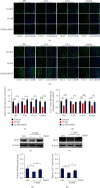Photobiomodulation Therapy Ameliorates Glutamatergic Dysfunction in Mice with Chronic Unpredictable Mild Stress-Induced Depression
- PMID: 33859781
- PMCID: PMC8024102
- DOI: 10.1155/2021/6678276
Photobiomodulation Therapy Ameliorates Glutamatergic Dysfunction in Mice with Chronic Unpredictable Mild Stress-Induced Depression
Abstract
Accumulating evidence indicates that dysfunction of the glutamatergic neurotransmission has been widely involved in the pathophysiology and treatment of depression. Photobiomodulation therapy (PBMT) has been demonstrated to regulate neuronal function both in vitro and in vivo. Herein, we aim to investigate whether the antidepressant phenotype of PBMT is associated with the improvement of glutamatergic dysfunction and to explore the mechanisms involved. Results showed that PBMT decreased extracellular glutamate levels via upregulation of glutamate transporter-1 (GLT-1) and rescued astrocyte loss in the cerebral cortex and hippocampus, which also alleviated dendritic atrophy and upregulated the expression of AMPA receptors on the postsynaptic membrane, ultimately exhibiting behaviorally significant antidepressant effects in mice exposed to chronic unpredictable mild stress (CUMS). Notably, PBMT also obtained similar antidepressant effects in a depressive mouse model subcutaneously injected with corticosterone (CORT). Evidence from in vitro mechanistic experiments demonstrated that PBMT treatment significantly increased both the GLT-1 mRNA and protein levels via the Akt/NF-κB signaling pathway. NF-κB-regulated transcription was in an Akt-dependent manner, while inhibition of Akt attenuated the DNA-binding efficiency of NF-κB to the GLT-1 promoter. Importantly, in vitro, we further found that PKA activation was responsible for phosphorylation and surface levels of AMPA receptors induced by PBMT, which is likely to rescue excitatory synaptic transmission. Taken together, our research suggests that PBMT as a feasible therapeutic approach has great potential value to control the progression of depression.
Copyright © 2021 Di Zhang et al.
Conflict of interest statement
The authors declare that they have no known competing financial interests or personal relationships that could have appeared to influence the work reported in this paper.
Figures





Similar articles
-
Deficiency of astrocyte CysLT1R ameliorates depression-like behaviors in mice by modulating glutamate synaptic transmission.Neurobiol Dis. 2022 Dec;175:105922. doi: 10.1016/j.nbd.2022.105922. Epub 2022 Nov 10. Neurobiol Dis. 2022. PMID: 36371059
-
Photobiomodulation (660 nm) therapy reduces oxidative stress and induces BDNF expression in the hippocampus.Sci Rep. 2019 Jul 12;9(1):10114. doi: 10.1038/s41598-019-46490-4. Sci Rep. 2019. PMID: 31300736 Free PMC article.
-
Activation of PKA/SIRT1 signaling pathway by photobiomodulation therapy reduces Aβ levels in Alzheimer's disease models.Aging Cell. 2020 Jan;19(1):e13054. doi: 10.1111/acel.13054. Epub 2019 Oct 30. Aging Cell. 2020. PMID: 31663252 Free PMC article.
-
Therapeutic potential of intranasal photobiomodulation therapy for neurological and neuropsychiatric disorders: a narrative review.Rev Neurosci. 2020 Apr 28;31(3):269-286. doi: 10.1515/revneuro-2019-0063. Rev Neurosci. 2020. PMID: 31812948 Free PMC article. Review.
-
Parameters and Effects of Photobiomodulation in Plantar Fasciitis: A Meta-Analysis and Systematic Review.Photobiomodul Photomed Laser Surg. 2019 Jun;37(6):327-335. doi: 10.1089/photob.2018.4588. Epub 2019 May 20. Photobiomodul Photomed Laser Surg. 2019. PMID: 31107161
Cited by
-
Photobiomodulation attenuates oligodendrocyte dysfunction and prevents adverse neurological consequences in a rat model of early life adversity.Theranostics. 2023 Jan 16;13(3):913-930. doi: 10.7150/thno.78777. eCollection 2023. Theranostics. 2023. PMID: 36793860 Free PMC article.
-
The Role of Photobiomodulation to Modulate Ion Channels in the Nervous System: A Systematic Review.Cell Mol Neurobiol. 2024 Nov 23;44(1):79. doi: 10.1007/s10571-024-01513-1. Cell Mol Neurobiol. 2024. PMID: 39579175 Free PMC article.
-
Photobiomodulation therapy in mood disorders: a systematic review.Lasers Med Sci. 2022 Dec;37(9):3343-3351. doi: 10.1007/s10103-022-03641-w. Epub 2022 Nov 21. Lasers Med Sci. 2022. PMID: 36404359
-
Glutamatergic System in Depression and Its Role in Neuromodulatory Techniques Optimization.Front Psychiatry. 2022 Apr 14;13:886918. doi: 10.3389/fpsyt.2022.886918. eCollection 2022. Front Psychiatry. 2022. PMID: 35492692 Free PMC article. Review.
-
Near-Infrared Photobiomodulation of Living Cells, Tubulin, and Microtubules In Vitro.Front Med Technol. 2022 May 4;4:871196. doi: 10.3389/fmedt.2022.871196. eCollection 2022. Front Med Technol. 2022. PMID: 35600165 Free PMC article.
References
-
- GBD 2015 Disease and Injury Incidence and Prevalence Collaborators. Global, regional, and national incidence, prevalence, and years lived with disability for 310 diseases and injuries, 1990-2015: a systematic analysis for the Global Burden of Disease Study 2015. The Lancet. 2016;388(10053):1545–1602. doi: 10.1016/S0140-6736(16)31678-6. - DOI - PMC - PubMed
MeSH terms
Substances
LinkOut - more resources
Full Text Sources
Other Literature Sources

